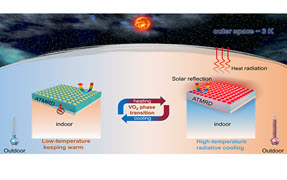Silicon Photonics Integration
The infrastructure for tomorrow’s information and communication technologies (ICT) requires ever-higher bandwidth and more energy-efficient data communication to accommodate the increasing amount of data traffic. For this, optical data transmission is key.
Fiber-optic solutions are already well established in long-reach metropolitan and access networks and in supercomputing infrastructure. But on-chip, high-performance central processing units and dynamic random-access memories will also be interfaced with input/outputs that require even higher bandwidths, equaling or surpassing 1TB/s by 2018.
Optical links are therefore being considered for package-to-package interconnects and even on-chip interconnects. For all these applications, the expected advantage of optical data transfer is to provide more aggregate bandwidth at less power consumption than today’s electronic data transfer over copper.
Among the various technologies for optical components, silicon photonics holds the most potential for building and integrating these components and having a small footprint, low power consumption, low cost, and scalability for high-speed telecom and datacom applications.
A platform that can combine various high-quality passive and active components in one single integration flow will power the adoption of silicon photonics circuits.
With such a platform, integrated photonics circuits can be made with single-channel data rates up to 25Gb/s. High aggregate bandwidth can be enabled by using a wavelength-division-multiplexing (WDM) architecture or spatial-division-multiplexing (SDM) architecture.
According to a July 2014 report by Yole Développement, the market for Si photonics devices is projected to grow from US $25 million in 2013 to about $50 million in 2017 and over $700 million in 2024. This market to replace electrons with photons will include applications in high-performance computing, data centers, and telecom as well as sensors in the medical and consumer fields.
Si photonics can be used to realize highly sensitive optical devices for monitoring strain, temperature, or gases. The technology can also be used in chip-based circuits for portable point-of-care devices or implants.
A complete optical link needs many different components. On the transmitter side, an electronic driver converts a standard CMOS bit state into an electrical current compatible with the optical device (a laser diode). A modulator then converts the electrical signal into an optical signal.
On the receiver side, a photodetector converts the optical signal into a photocurrent, and a transimpedance amplifier (TIA) transforms the photocurrent into a standard CMOS bit state.
Most optical communication networks adopt the technique of WDM to minimize the number of fibers needed to carry a given bandwidth. This approach is also being considered for short-distance optical links to increase the bandwidth density through packages.
In a WDM link, signals are encoded onto different carrier wavelengths, which are transmitted independently through the same physical channel. The carriers are typically generated using lasers that operate at different wavelengths. A modulator then imprints the signal onto the carrier, and the signals are joined together in a multiplexer. On the receiver side, the wavelengths are demultiplexed and sent to a photodetector.
Waveguide-based silicon photonics is an attractive technology for integrating all building blocks necessary to construct WDM links on a single chip. It allows fabricating optical components with state-of-the-art semiconductor equipment, using the same processes and tools as for the fabrication of state-of-the-art chips.
This technology is also very challenging. Besides the development of the individual passive and active components, component integration into a complex circuit – and ultimately with electronics (drivers and amplifiers) – is not straightforward. A well-known weakness of Si photonics technology is its high sensitivity to the waveguide dimensions, which requires nm-scale control over a full wafer.
Also, Si photonics waveguide-based components are typically very thermally dependent because of the large variation of the Si refractive index with temperature. Compensating for this is possible with active tuning and temperature control, but this can severely impact the power consumption of the optical link.
The silicon photonics platform developed by imec enables the implementation of a complete WDM architecture. The platform uses 200mm silicon-on-insulator (SOI) wafers as a substrate, with a 220nm Si layer above a 2000nm buried oxide. The fabrication process uses a modified 130nm CMOS flow augmented with 193nm lithography for all the waveguide patterning layers. An additional oxide/poly-Si stack is deposited to allow for more degrees of freedom in the design of the optical components.
This stack is used for integrating the advanced passive components, like grating couplers and waveguides. With the integration platform, passive components as well as active components (such as opto-electronic modulators, heaters, and Ge-on-Si photodetectors) can be co-integrated.
The platform allows for the making of integrated photonics circuits for the telecom and datacom industries with single-channel data rates up to 25Gb/s. Also, the Si thickness variation can be controlled to about 2.5nm across a 200mm wafer. The electronics circuits (like drivers and TIAs) can be fabricated on a separate die and assembled with the Si photonics circuits using flip-chip assembly methods.
Using this Si photonics technology, we integrated the key building blocks for realizing a WDM architecture: 1.0V drivers with microring modulators and microring filters with efficient thermal tuning.
The proposed architecture contains a continuous-wave laser source that is coupled onto a silicon photonics circuit using a single polarization-grating coupler. The unmodulated WDM light can be split through a broadband splitter to ‘power’ multiple parallel links.
Each wavelength is then modulated by separate microring resonators that change their absorption based on the associated driver voltage. Each modulator can operate at high speeds up to 25Gb/s. They are driven by CMOS drivers that operate at 1.0V power supply.
These microring modulators are chosen for their compactness, which limits the drivers’ complexity and power consumption. An integrated heater is used to tune the microring to the desired wavelength. The WDM signal then couples out through a single polarization coupler into a fiber array.
The WDM receiver is based on the demultiplexing of the WDM signal by using 4-channel double-microring-based demultiplexer second-order filters. By using these types of filters, the impact of the local process variability on insertion loss and crosstalk can be mitigated.
First, the signal is coupled onto the silicon photonics circuit through a polarization-splitting coupler that sends each polarization to a different waveguide. Next, for each polarization, each wavelength is filtered out and coupled to a single Ge-on-Si photodetector per wavelength, followed by a TIA that amplifies the photocurrent generated in the detector. The filters are made with microring filters and are tuned to the desired wavelength with integrated heaters.
In the future, we will explore the limits of our approach to realize even denser and more power-efficient WDM architectures.
Recently, very promising results have been obtained by implementing a so called ‘UCUT’ module in the back-end-of-line of the Si photonics platform. After copper metallization, we etched locally through the top stack into the substrate, undercutting a buried oxide.
This way, critical devices can be better thermally isolated, improving the efficiency of the heater. By applying this module on a WDM-filter, a strongly improved thermo-optic tuning efficiency was obtained: the filter can be tuned over >14nm at less than 0.5pJ/bit. The same UCUT module was successfully applied on a ring modulator.
More details of this research can be found in:
- “Advances in silicon photonics WDM devices,” presented at OPTO, part of SPIE Photonics West, in February 2014
- "Highly uniform 28Gb/s Si photonics platform for high-density, low-power WDM optical interconnects,” presented at Integrated Photonics Research, Silicon and Nanophotonics in July 2014
— Philippe Absil is director of the 3D and Optical Technologies Department at imec (Belgium) and has been responsible for the development of imec’s silicon photonics technology platform since 2010. Before that, he managed the advanced CMOS scaling program at imec and developed the passive photonics platform technology for Little Optics Inc. (USA). Research for his PhD at University of Maryland at College Park (USA) contributed to the early demonstrations of semiconductor microring resonators. Absil is a member of the program committee for the conference on Next-Generation Optical Networks for Data Centers and Short-Reach Links at SPIE Photonics West.
|
Communications and IT are priorities for NPI
|
The National Photonics Initiative (NPI), a collaborative alliance to raise awareness of photonics and drive US funding and investment in key photonics-driven fields, recognizes the important role that photonics can play in next-generation data centers, high-performance computing, and integrated components for communication technologies.
Communications and information technology is, therefore, one of five key priorities for the NPI.
An NPI white paper recommends strategic investment in a National Photonics Prototyping and Advanced Manufacturing Facility to advance photonics-enabled telecom and datacom technologies.
More information: www.lightourfuture.org.
- Have a question or comment about this article? Write to us at spieprofessional@spie.org.
- To receive a print copy of SPIE Professional, the SPIE member magazine, become an SPIE member.



